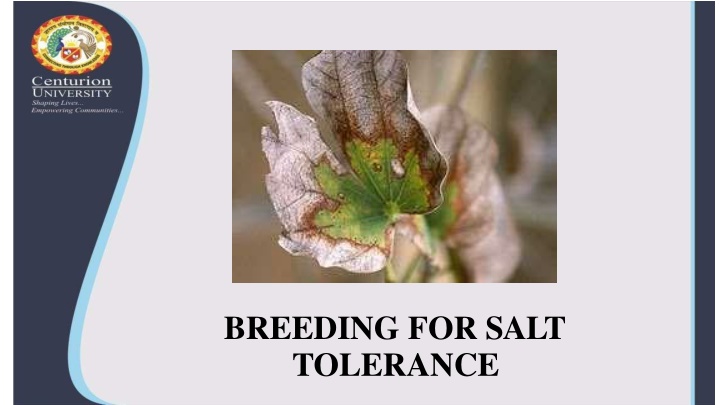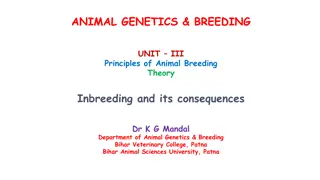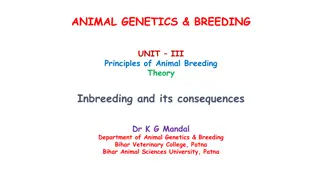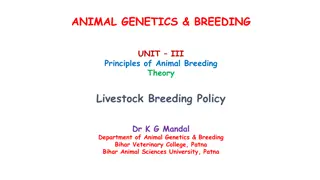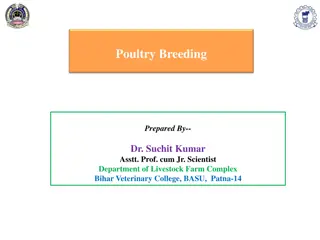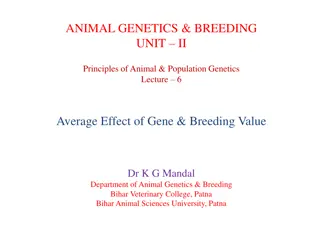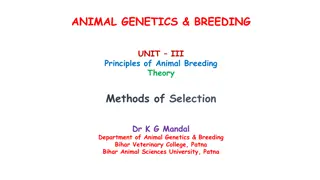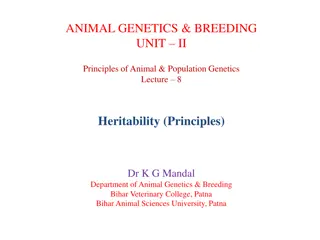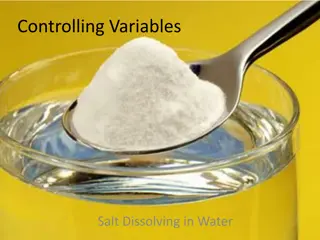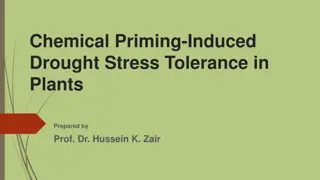Breeding for Salt Tolerance in Plants
Salt tolerance in plants is crucial for overcoming the harmful effects of soluble salts in soil. Different plant varieties exhibit varying levels of salt tolerance, with some crops being highly tolerant while others are more sensitive. Understanding the behavior and characteristics of plants towards salt stress, as well as the mechanisms of salt tolerance, can aid in developing resilient crop varieties. Breeding methods play a key role in selecting and developing salt-tolerant plant varieties to address global salinity issues.
Uploaded on Mar 07, 2025 | 0 Views
Download Presentation

Please find below an Image/Link to download the presentation.
The content on the website is provided AS IS for your information and personal use only. It may not be sold, licensed, or shared on other websites without obtaining consent from the author.If you encounter any issues during the download, it is possible that the publisher has removed the file from their server.
You are allowed to download the files provided on this website for personal or commercial use, subject to the condition that they are used lawfully. All files are the property of their respective owners.
The content on the website is provided AS IS for your information and personal use only. It may not be sold, licensed, or shared on other websites without obtaining consent from the author.
E N D
Presentation Transcript
BREEDING FOR SALT TOLERANCE
Salt Tolerance: refers to the ability of plants to prevent, reduce or overcome injurious effects of soluble salts present in their root zone. It is a global problem as saline and alkali soils are fond in almost all the countries of the world, more in Semi Arid Tropic (SAT) of world. Problem of salinity can be overcome by two ways: 1. Soil reclaimation : costly, time consuming and short lived 2.Resistant varieties : less costly, more effective, long lasting require longer period to develop.
Behavior/ characteristics of plants to salt : 1.Land races more tolerant than High yielding varieties. Tolerant plants varieties are found is salt affected areas 2.Salt tolerance capacity differs from species to species. Also genetic differences exist among cultivars for their salt tolerance capacity. 3. Different crop plants show differential response to salinity 4.Higher ploidy level crops are more tolerant than lower ploidy level crops. Eg. Hexaploid wheat more tolerant than tetraploid Tetraploid Brassica more tolerant than diploid Brassica 5.In rice tall, coarse grained, late maturing varieties-
6.In sugarcane different strains have differential tolerance; Barley is more tolerant than wheat. a.Highly tolerant crops: Sugabeet, sunflower, barley (grain), cotton, datepalm, asparagus b.Moderately Tolerant crops: Barley (Forage), rye, sorghum, wheat, safflower, soybean c.Moderately sensitive: Rice, corn, foxtail millet, cow pea, peanut, sugarcane, tomato, potato, sweet potato, radish, alfalfa, cabbage d.Extremely sensitive: Citrus, straw berry, melon, peas, other legumes, apple, rajmabean, carrot, okra, onion (orange)
Symptoms of plants to salt stress : 1. Retardation / cessation of growth 2. Necrosis 3. Leaf abscession 4. Loss of turgor 5. Ultimate death of plant Mechanisms of salt tolerance : 2 types of mechanisms 1. Salt Tolerance : Plants respond to salinity stress by accumulating salt, generally in their cells or glands and roots etc.
2. Salt avoidance : plants avoid salt stress by maintaining their cell salt concentration unchanged either by water absorption eg. Rice, chenopodiaceae family or by salt exclusion eg. Tomato, soybean, citrus, wheat grass Glycophytes (Non-halophytes) plants owe their resistance primarily to avoidance. Eg. Barley Hallophytes (plants that grew in salty or alkaline soils) show tolerance by ion accumulation mechanism
Breeding methods Breeding methods are same but breeding strategies are 1.Breeding for yield potential should have greater emphasis than breeding for salt resistance per se (As screening is done on the basis of yield reduction in stress environment as compared to non-stress Environment.). 2.Selection should be done is stresses target environments (As abiotic stress resistance is an important part of Environ. Fitness & is bound to be location specific i.e. it is related to narrow adaptation.
